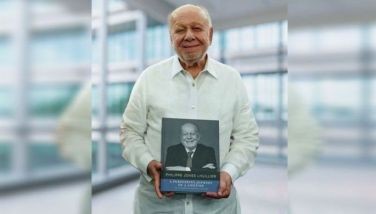Restoring sanity

April 26, 2006 | 12:00am
It’s a reflection of the sorry state of the nation that concerned sectors are reading only what they want to read in recent Supreme Court rulings on two controversial cases.
The first involves Executive Order 464, portions of which were declared unconstitutional by the high court. The second, issued yesterday as the SC justices prepared to return to Manila from Baguio City, declared the administration’s "calibrated preemptive response" or CPR unconstitutional.
Both the opposition and the administration claimed some victory in the two cases. Some of the reactions were out of this world. Several lawmakers obviously did not bother to read the decisions or even listen to the nuances of the rulings that were painstakingly explained by Supreme Court assistant administrator and spokesman Ismael Khan Jr.
In both cases, the Supreme Court was actually trying to restore order and sanity in our dysfunctional society, reminding both Malacañang and Congress of the separation of powers and the need for civility, and reminding everyone that rights must be exercised with responsibility.
The tribunal said as much in its decision yesterday, which declared CPR unconstitutional but upheld the validity of Batas Pambansa 880, the Public Assembly Act that was passed during the regime of dictator Ferdinand Marcos. BP 880 lays down the "no permit, no rally" policy except in so-called freedom parks to be designated by local governments. I don’t know how anti-Marcos militants will respond to this part of the ruling.
So far the responses to the decision on EO 464 have not been encouraging. Some opposition lawmakers are giving the impression that they are preparing for an inquisition binge. The salivating is almost obscene.
The administration has fared little better, warning that the ruling allows President Arroyo to invoke her executive privilege and prevent any executive official from facing Congress if she deems that a congressional hearing is not in aid of legislation.
This battle is far from over.
For Filipinos sick of endless political bickering, the SC ruling merely set the boundaries in a system where there is supposed to be separation of powers. The executive and legislative branches in particular have lost institutional respect for each other – not that this is surprising, given the quality of many of the officials in the two branches.
Many quarters have lamented that civility has disappeared from the Philippine body politic. By text and e-mail, through mass media and street protests, we disparage each other in the most spiteful ways. Informed debate requires too much effort, and beyond the capability of many street protesters as well as some of the people we have elected to public office.
The principle of separation of powers, however, is not a license for abuse of power. It does not mean staying out of each other’s monkey business. The principle is supposed to promote a system of checks and balances among the three branches of government, including the exercise of executive privilege and congressional powers.
This system the Supreme Court hoped to uphold in its ruling on E0 464. It wants an end to what we describe as congressional investigations in aid of re-election, but it also discourages the executive from stonewalling on matters of legitimate public concern, such as the possible misuse of public funds.
Now the tribunal, in striking down CPR, has emphasized that there are no absolute rights. It has often been pointed out that if everyone exercised absolute rights, it wouldn’t be democracy but anarchy.
This detail has always been lost on the noisy militants whose idea of promoting their causes is by making life miserable for thousands of motorists and commuters all over Metro Manila. They gauge the success of their campaigns by the degree of public disruption they create: monumental traffic jams, suspension of classes in Mendiola.
In its ruling, the Supreme Court emphasized that peaceable assembly must be peaceful and for a legal cause, otherwise it cannot be protected by the legal system.
Peaceful public assemblies must continue to enjoy the state’s policy of maximum tolerance, the tribunal ruled. But organizers of such assemblies must get a permit from the local government, which in turn must decide on the application within two days. Peaceful assemblies can be held without a permit only in "freedom parks" that local governments must designate pronto, or else all the parks in their respective jurisdictions will be considered freedom parks.
Many Filipinos, too busy with the day-to-day task of survival, can hardly care about the latest efforts to oust another president. As long as they can work and get on with their lives in peace, they don’t care if militant groups slander anyone and demand to bring down everything. If the militants can bring down prices, so much the better. As long as they stay in areas designated for protest.
But you’ve seen the response of anti-government groups to the designation of freedom parks. I remember the Manila government designating Plaza Miranda in Quiapo and Liwasang Bonifacio in Ermita as the city’s freedom parks. Have rallies in the city been confined to these areas? Where’s the fun in staging rallies in places where these are allowed? If you can’t be a public nuisance, your message is lost.
Will protesters heed the Supreme Court on this one? Will local government officials finally move their butts and identify those freedom parks?
And has Malacañang learned its lesson on the price of paranoid overreaction?
The Supreme Court has spoken. In a democracy, there is no room for absolute power. Neither is there room for absolute rights.
Is anyone listening? You wish.
The first involves Executive Order 464, portions of which were declared unconstitutional by the high court. The second, issued yesterday as the SC justices prepared to return to Manila from Baguio City, declared the administration’s "calibrated preemptive response" or CPR unconstitutional.
Both the opposition and the administration claimed some victory in the two cases. Some of the reactions were out of this world. Several lawmakers obviously did not bother to read the decisions or even listen to the nuances of the rulings that were painstakingly explained by Supreme Court assistant administrator and spokesman Ismael Khan Jr.
In both cases, the Supreme Court was actually trying to restore order and sanity in our dysfunctional society, reminding both Malacañang and Congress of the separation of powers and the need for civility, and reminding everyone that rights must be exercised with responsibility.
The tribunal said as much in its decision yesterday, which declared CPR unconstitutional but upheld the validity of Batas Pambansa 880, the Public Assembly Act that was passed during the regime of dictator Ferdinand Marcos. BP 880 lays down the "no permit, no rally" policy except in so-called freedom parks to be designated by local governments. I don’t know how anti-Marcos militants will respond to this part of the ruling.
The administration has fared little better, warning that the ruling allows President Arroyo to invoke her executive privilege and prevent any executive official from facing Congress if she deems that a congressional hearing is not in aid of legislation.
This battle is far from over.
For Filipinos sick of endless political bickering, the SC ruling merely set the boundaries in a system where there is supposed to be separation of powers. The executive and legislative branches in particular have lost institutional respect for each other – not that this is surprising, given the quality of many of the officials in the two branches.
Many quarters have lamented that civility has disappeared from the Philippine body politic. By text and e-mail, through mass media and street protests, we disparage each other in the most spiteful ways. Informed debate requires too much effort, and beyond the capability of many street protesters as well as some of the people we have elected to public office.
The principle of separation of powers, however, is not a license for abuse of power. It does not mean staying out of each other’s monkey business. The principle is supposed to promote a system of checks and balances among the three branches of government, including the exercise of executive privilege and congressional powers.
This system the Supreme Court hoped to uphold in its ruling on E0 464. It wants an end to what we describe as congressional investigations in aid of re-election, but it also discourages the executive from stonewalling on matters of legitimate public concern, such as the possible misuse of public funds.
This detail has always been lost on the noisy militants whose idea of promoting their causes is by making life miserable for thousands of motorists and commuters all over Metro Manila. They gauge the success of their campaigns by the degree of public disruption they create: monumental traffic jams, suspension of classes in Mendiola.
In its ruling, the Supreme Court emphasized that peaceable assembly must be peaceful and for a legal cause, otherwise it cannot be protected by the legal system.
Peaceful public assemblies must continue to enjoy the state’s policy of maximum tolerance, the tribunal ruled. But organizers of such assemblies must get a permit from the local government, which in turn must decide on the application within two days. Peaceful assemblies can be held without a permit only in "freedom parks" that local governments must designate pronto, or else all the parks in their respective jurisdictions will be considered freedom parks.
Many Filipinos, too busy with the day-to-day task of survival, can hardly care about the latest efforts to oust another president. As long as they can work and get on with their lives in peace, they don’t care if militant groups slander anyone and demand to bring down everything. If the militants can bring down prices, so much the better. As long as they stay in areas designated for protest.
But you’ve seen the response of anti-government groups to the designation of freedom parks. I remember the Manila government designating Plaza Miranda in Quiapo and Liwasang Bonifacio in Ermita as the city’s freedom parks. Have rallies in the city been confined to these areas? Where’s the fun in staging rallies in places where these are allowed? If you can’t be a public nuisance, your message is lost.
Will protesters heed the Supreme Court on this one? Will local government officials finally move their butts and identify those freedom parks?
And has Malacañang learned its lesson on the price of paranoid overreaction?
The Supreme Court has spoken. In a democracy, there is no room for absolute power. Neither is there room for absolute rights.
Is anyone listening? You wish.
BrandSpace Articles
<
>
- Latest
- Trending
Trending
Latest
Latest
Recommended

December 1, 2024 - 12:32pm

November 30, 2024 - 6:30pm

























